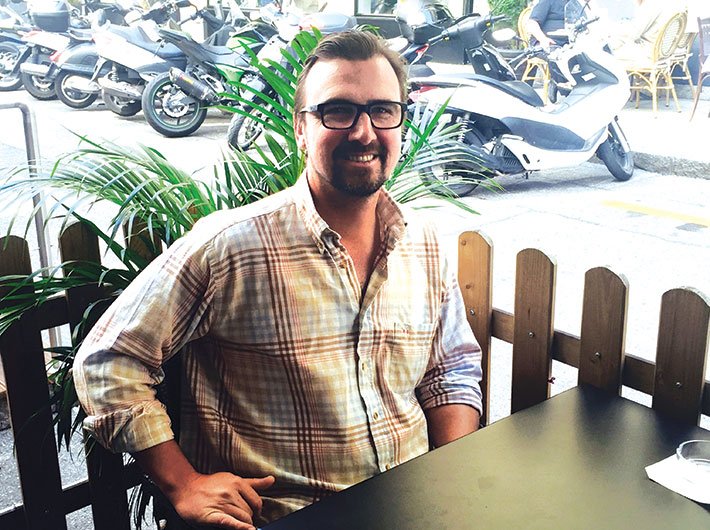A Swiss chocolatier shares the saga of an adventure undertaken five generations ago
When the US secretary of state, John Kerry, toppled off his bike in the picturesque village of Scionizer in June he had already achieved his twin objectives that have become constants with his Geneva trips over the last two years. The first objective of negotiating with the Iranians to thrash out a nuclear deal attracts much multilateral attention and occupies dedicated space in newsprint globally. The second objective, however, which is equally a holy grail for Kerry but unknown to the world, are his visits to his favourite chocolate shop, Auer Chocolatier, to get truffles for his wife, Teresa Heinz Kerry.
“He got his truffles this time too,” says Philippe Henri Auer, owner of the shop, in a thick French accent. “I hope he gets well soon and returns to Geneva,” he adds.
It is no mean feat that Auer’s family has achieved to carve a niche for their pralines and truffles in a country renowned for its brown magic.
“I am the fifth generation in the confiserie business. The adventure started with my great great-grandfather, Henri Auer, around 1830. At this time there was no work in Switzerland so he moved to Tulon in France and built a very famous confiserie and boulangerie. There were no chocolates in this period, there were only chocolate beverages,” Auer says alternating between French and English.
Technically, there were chocolates in this period though not the rich delights that we are familiar with today – chocolates then were basically an expensive and crude mix of cocoa and sugar imported from the colonies.
When Henri Auer was in France tending to his boulangerie, four chocolatiers – François-Louis Cailler, Charles-Amédée Kohler, Daniel Peter and Henri Nestle – around the north shore of Lake Geneva in Switzerland were working fervently to bring chocolate to the masses.
The town of Vevey, in particular, was turning out to be a hotspot for chocolate innovations with the four competing against each other but equally interested in the other’s innovation. François-Louis Cailler, the first Swiss producer of chocolate and founder of Cailler chocolates, had already set up a chocolate factory in Vevey in 1819. Charles-Amédée Kohler, who invented hazelnut chocolate in 1830, also had a factory but still produced it in the form of a drink.
The invention of the milk chocolate, for which Switzerland is known today, however, was a result of serendipity on at least two counts. The candle-maker Daniel Peter’s marriage to chocolatier Cailler’s daughter, Fanny, and the happy coincidence of Peter and Henri Nestle – the founder of Nestle, the company that has caused much heartache to the Indian government in recent days – being neighbours.
Peter’s experiments of mixing cow milk, which had too much water, with cocoa, with its fatty content, were failing because the two were impossible to mix. He found the solution in his neighbour Nestle’s invention of condensed milk – where part of the water was already extracted from the milk. Thus, Peter brought the powder milk chocolate to the market and milk chocolates in the form of bars in 1875.
With so much innovation emerging from a concentrated space it is difficult to say with certainty who invented what but Peter, who got a notary certification first, is recognised as the inventor of milk chocolates.
Within the next two decades, the biggest chocolate industries had been established: Cailler and Peter joined firms in Broc but were eventually bought over by Nestle, Philippe Suchard in Serrières, Lindt and Tobler in Bern.
“My grandfather, Gaspar Auer, came back to Switzerland, married a Swiss girl and opened a confiserie, pattiserie and boulangerie near the gas station in Geneva. But since 1939 we are doing only chocolates. At this period (sic) even if the chocolates were artisanal they were more like bars. And my grandfather was the first [in Geneva] to make bonbon of chocolates. We were one of the first producers of artisanal chocolates in Geneva,” Auer says with beaming pride.
“The period from the 1940s to the 1950s was the beginning of [the popularity of] bonbons. Making bonbons is like making jewellery. He [Gaspar] had around 25 to 30 types of bonbons. The influence was Italian pralines and gianduja. Italians were not specialists in chocolates but they were always specialists in nuts and pasta,” says Auer, reminiscing of his chocolatier grandfather who died before Philippe was born.
We have to imagine that he started the business in 1939 during the World War II. It was a hard time. Everything was rationnée [rationed] – milk was rationnée, bread was rationnée. However, at this time also, Geneva was a place where a lot of big names, big families including the Russian royalties, Hollywood and French stars of the 1950s came, because it was quite a safe place in Europe. Big names [came] and with them fortunes came,” adds Auer.
By the fourth quarter of the 19th century, Switzerland had become a popular destination with the British middle class. It began with an imaginative, young cabinet-maker called Thomas Cook making a trip in 1863, primarily to gather information, with 60 people all the way up to Geneva and further on.
Cook had already taken 500 tourists to Switzerland by the end of 1863. With Cook’s invention of hotel coupons and circular notes in 1874, travel became easier than ever before, thus marking a flurry of middle and upper class tourists to Geneva. The combination of healthy Swiss milk along with cocoa beans caught the imagination of English tourists making the industrial production of chocolate a profitable venture.
Apart from emerging as an affordable holiday destination for the typical middle classes from the UK, Switzerland also became the place where the rich and famous came to live out their last days. And the list of those who opted for a final resting place in this beautiful Alpine country is long, including Charlie Chaplin, Graham Greene, James Mason, Coco Chanel, James Hadley Chase, David Niven, Vladimir Nabokov, Audrey Hepburn, Jorge Luis Borges, Alistair MacLean and David Niven. In fact the graves of Charlie Chaplin, Graham Greene and James Mason lie almost side-by-side in the Corsier-sur-Vevey cemetery.
“This is how Auer became famous because of the tourists. My father took up the business in 1967 when my grandfather died. It was a fast-growing period for Geneva. There was a crisis in Europe from the 1970s to the 1990s but the same period was fabulous for Geneva. We say those were the best years of the [last] century,” Phillippe says with a broad smile and nostalgic eyes.
“My father expanded to about 50 to 55 bonbons. Now I am trying to keep it to 65. It’s always difficult when you do a new chocolate but you cannot do new chocolates every year and keep the old ones. So it’s tricky and to choose the ones that don’t work anymore as the clients demand ‘where are my chocolates?’.”
According to the Association of Swiss Chocolate Manufacturers, the per-capita consumption in Switzerland based on domestic consumption (excluding powder) is 11.7 kg. Around 63 percent of the chocolates were exported in 2014 to 152 countries with Germany being the single largest recipient. Surprisingly, however, the chocolate industry had an annual turnover of only about 1.7 billion Swiss francs and employed a little over 4,500 people – with more men employed than women – in 2014.
“We [Auer] are known for the Amandes Princesse [almond princess bonbons]. And it is my father who came back with this recipe and then I developed this project. We have new flavours like lemon, caramel with salt and butter – it’s a trendy flavour.”
Auer has some famous clients apart from Kerry but Philippe strangely refuses to divulge the names. One would have thought that politicians ought to have more to be ashamed of than having a sweet tooth.
“We don’t work like other businesses who want to make different shops in Paris, London. I have a lot of propositions but I don’t want. Because our shop, our business, is like Patek Philippe. You never own [buy] it. You have it and you must give it to your next generation. It’s [an] exclusive one spot in the world. I work hard for its reputation to give it to my son. I am proud to give good chocolates to everybody. I want to have class but also stay popular. Basta [enough],” says Auer raising his palm in a gesture of charming finality.
[email protected]



